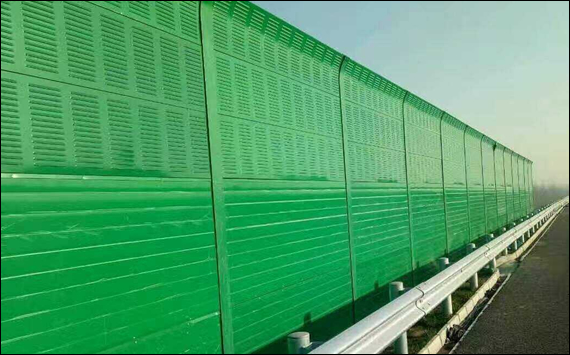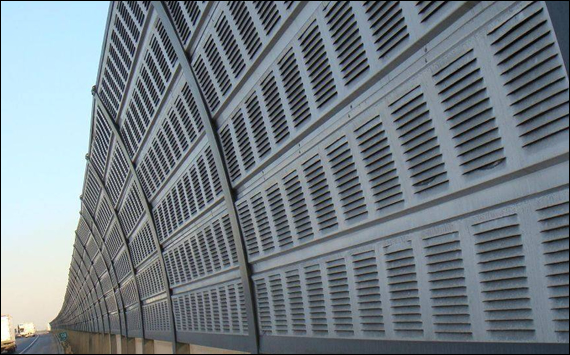YOU ARE HERE:
Home » Products » Noise Barrier Panels » Perforated Metal Noise Barrier
Perforated Metal Noise Barrier Panels are made of perforated metal materials Pre Painted or Powder Coated into a variety of colors, supplied in sandwiched panels with flexible dimensions to suit different highway and railway projects.
Typical structures: Inner perforated metal sheet + Sound Absorption Filling + outer perforated sheet
Aluminum perforated noise barrier

Panel thickness: 80 and 100 mm,
metal plate thickness: 0.8 mm
Barrier panel size: 2500x500x80 and 2500x500x100
Perforated Noise Barrier Panels, for project in Sydney, Australia

Slot perforated metal noise barrier
Technical specifications:
Noise Barrier Panels
Dimension 3000mm(L)x500mm(W)x100mm(T).
Outer Sheet Aluminium: Pre Painted/Powder Coated 1.2mm Thick
Inner Sheet Perforated
Aluminium: Pre Painted/Powder Coated 1.2mm Thick
Sound Absorption filling: water repellent rock wool or equivalent mim density 64k.g/m cube
Erection of the dispersion and absorption types noise barrier to the set location
MATERIALS
Panels
Panels with accessories: Dispersive type and absorptive panels to attenuate noise level design, to withstand the minimum wind pressure of 150 kg/m2. The noise absorption panels are manufactured from durable material to last a long life of at least 20 years with minimum maintenance
Property of noise barrier:
Sound absorption coefficient: min. 70% at 400 Hz; 80% at 1000 Hz.
Designed with protection system, not to drop off from the frame.
Designed against wind load 100kg.
With a safety barrier
Noise barrier sheet: Perforated hole
All steel frame, fixings, spacers and bolts for installing of acoustic panels are supplied.
Panels Average Strengths:
| Ultimate bending Strength (in 4 points — bending) |
21 | N/sq.mm. |
| Ultimate Tensile Strength | 8 | N/sq.mm. |
| Outer-plane Shear Strength | 30 | N/sq.mm. |
| In-plane Shear Strength | 8 | N/sq.mm. |
| Interfacial Stresses Strength | 1.7 | N/sq.mm. |
The allowable stresses in panel:
| Design Stresses | Allowable Stresses N/sq.mm. | |
| Short Term | Long Term | |
| Bending | 7 | 5 |
| Tensile | 4 | 2.5 |
| Outer-Plane Shear | 7 | 5 |
| In-Plane Shear | 4 | 2.5 |
| Interfacial Shear | 0.7 | 0.5 |
Noise Barrier Wall
Nnoise barrier wall is furnished and completely installed to the acceptable standard and workmanship.
As a guide, an indicated range of mix proportion:
| Water to Cement Ratio | 0.38 maximum |
| Sand to Cement Ratio | 0.30 minimum |
| Glass Fiber | 4.5 to 6.0 percent by weight to cement for spray-up process, or 3.5 to 4.5 percent for premix process. |
Glass fiber conforms to the requirements of GRCA SO 105/0286 and be alkaline resistance type of equipment approved by the Engineer.
The minimum panel skin thickness shall be as follows:
Dispersive Panel: 8 mm.
Absorptive Panel: 10 mm.
Lattice Screen: 20 mm.
Insect screen shall be polymer-coated fiber glass type
Sound absorbing medium shall be fiber glass board with minimum density of 32 kg/m2 comply with AS 1045/1971 - Sound Absorption Co-efficient.
Sound barrier layer shall be rigid PVC film of not less than 0.44 mm. thick.
Acoustic Performance
The noise barrier system supply shall be tested for acoustic performance to ensure efficient and effective noise attenuation properties requirements as specified.
Acoustic Testing
Acoustic Tests shall be conducted by an independent testing laboratory registered for testing Airborne Sound Transmission Loss and Sound Absorption in a Reverberation Room.
Acoustical Tests shall be carried out on prototype panels prior to the commencement of production.
Tests Method : Panels shall be tested for Airborne Sound Transmission Loss Using ISO Standard 140/1 and 140/3 (AS 1191-1985). The Sound Transmission Class shall be determined according to ASTM E 413 (AS 1276-1979).
Absorption Panels shall be tested to determine their Sound Absorption Coefficient according to ISO Recommendation R 354 (AS 1054).
Test Results Criteria :
Sound Transmission Loss : Panels shall exhibit a Sound Transmission Class of at least 34 and shall have Airborne Sound Transmission Losses. of no less than the values listed below:
| Frequency Hertz | Airborne Sound Transmission Loss (dB) |
| 100 | 20 |
| 125 | 21 |
| 160 | 26 |
| 200 | 27 |
| 250 | 29 |
| 315 | 30 |
| 400 | 32 |
| 500 | 33 |
| 630 | 33 |
| 800 | 33 |
| 1000 | 33 |
| 1250 | 35 |
| 1600 | 34 |
| 2000 | 35 |
| 2500 | 35 |
| 3150 | 34 |
| 4000 | 35 |
| 5000 | 35 |
Sound Absorption: The Sound Absorption Co-efficient of the Absorption
Absorpton Panels shall be no less than the values listed below
| Frequency Hertz |
Sound Absorption Co-efficient (Alpha) |
| 100 | 0.91 |
| 125 | 1.05 |
| 160 | 1.07 |
| 200 | 1.18 |
| 250 | 1.07 |
| 315 | 1.02 |
| 400 | 1.08 |
| 500 | 1.08 |
| 630 | 1.04 |
| 800 | 1.02 |
| 1000 | 0.93 |
| 1250 | 0.86 |
| 1600 | 0.77 |
| 2000 | 0.75 |
| 2500 | 0.81 |
| 3150 | 0.73 |
| 4000 | 0.63 |
| 5000 | 0.61 |